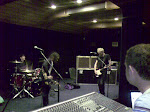
I've decided to fit a pickup to the awesome Linn record deck that's sat in my loft for the last decade as I have a couple of metres of great vinyl that's nagging me to be played. This reminds me of my old friend Andy Corrigan, who I shared a flat in Leeds with, along with Mark White, the two of them becoming the brilliant front men of the original Mekons.
Andy was an audiophile with a fine hi-fi system. Because of this he became Gang of Four’s first sound engineer . Having lied to us that he knew everything about sound gear , he took charge of our project to build a PA from scrap, army surplus parts and wood salvaged from fly tips. The system was built to his specification, using parts such as adapted 1/4" steel armour plated speaker drivers from WW2 airplanes - originally used to broadcast messages to troops on the ground - and an interesting sound recording device which used wire , not tape, and ran improbably slowly, so that you could hardly see it move. This turned out to be a seismological unit designed to measure earthquakes and not much good at recording music as it couldn’t record frequencies over 300Hz.
The PA horns were made from from plywood harvested from a dumped wardrobe . Overseen by Corrigan , Gill & I took turns holding a steaming kettle to the wood so that it softened and could be bent into the right shape. Corrigan was firmly of the view that, for optimum sound quality, the bass bins had to be extremely big and very, very, heavy. They were. Unfortunately, the PA was so huge that when we took it to Nottingham for a first try out in a tiny club, we couldn’t get it through the doors.
Corrigan’s next key acquisition was a powerful ex-army valve power amp. It was the perfect heart for our monster rig. But at our next show, Middlesborough, the internal circuitry melted when it was powered up. Andy and I mended it on the spot by soldering in place lengths of electrical cable recovered from a skip and made replacement fuses from fag ends wrapped in wire , assuming that a double wrap would have higher electrical resistance than a single wind. Rob Warr, our manager, thought this was very dangerous, but this would have been Health and Safety gone mad, so we ignored him. We were right as the amp , amazingly, didn’t catch fire until the end of the night, just after our final song. A great show, with pyro’s, too.
But do not do this at home.



正妹交友ggo正妹交友ggoo正妹交友gogo正妹視訊ggo正妹視訊ggoo正妹視訊go正妹視訊gogo成人交友ipkgirl成人交友qk176成人光碟cao正妹交友ggo正妹交友ggoo正妹交友gogo正妹視訊ggo正妹視訊ggoo正妹視訊go正妹視訊gogo成人交友ipkgirl成人交友qk176成人光碟cao正妹交友ggo正妹交友ggoo正妹交友gogo正妹視訊ggo正妹視訊ggoo正妹視訊go正妹視訊gogo成人交友ipkgirl成人交友qk176成人光碟cao正妹交友ggo正妹交友ggoo正妹交友gogo正妹視訊ggo正妹視訊ggoo正妹視訊go正妹視訊gogo成人交友ipkgirl成人交友qk176成人光碟cao
ReplyDeleteHey, Jon, I misread "Corrigan" as "Corgan" at first, and I became a little upset until I looked through the correct section of my bifocals' lenses.
ReplyDeletePlease, please, please tell me that you do not endorse Billy Corgan.
kthxbye
P.S. If you don't know who Billy Corgan is, don't bother looking it up.
ReplyDeleteSusan
ReplyDeleteI do not know who Billy Corgan is. I promise not to find out
Best
J